Yuzhe Liang
MeanAudio: Fast and Faithful Text-to-Audio Generation with Mean Flows
Aug 08, 2025Abstract:Recent developments in diffusion- and flow- based models have significantly advanced Text-to-Audio Generation (TTA). While achieving great synthesis quality and controllability, current TTA systems still suffer from slow inference speed, which significantly limits their practical applicability. This paper presents MeanAudio, a novel MeanFlow-based model tailored for fast and faithful text-to-audio generation. Built on a Flux-style latent transformer, MeanAudio regresses the average velocity field during training, enabling fast generation by mapping directly from the start to the endpoint of the flow trajectory. By incorporating classifier-free guidance (CFG) into the training target, MeanAudio incurs no additional cost in the guided sampling process. To further stabilize training, we propose an instantaneous-to-mean curriculum with flow field mix-up, which encourages the model to first learn the foundational instantaneous dynamics, and then gradually adapt to mean flows. This strategy proves critical for enhancing training efficiency and generation quality. Experimental results demonstrate that MeanAudio achieves state-of-the-art performance in single-step audio generation. Specifically, it achieves a real time factor (RTF) of 0.013 on a single NVIDIA RTX 3090, yielding a 100x speedup over SOTA diffusion-based TTA systems. Moreover, MeanAudio also demonstrates strong performance in multi-step generation, enabling smooth and coherent transitions across successive synthesis steps.
Kling-Foley: Multimodal Diffusion Transformer for High-Quality Video-to-Audio Generation
Jun 24, 2025Abstract:We propose Kling-Foley, a large-scale multimodal Video-to-Audio generation model that synthesizes high-quality audio synchronized with video content. In Kling-Foley, we introduce multimodal diffusion transformers to model the interactions between video, audio, and text modalities, and combine it with a visual semantic representation module and an audio-visual synchronization module to enhance alignment capabilities. Specifically, these modules align video conditions with latent audio elements at the frame level, thereby improving semantic alignment and audio-visual synchronization. Together with text conditions, this integrated approach enables precise generation of video-matching sound effects. In addition, we propose a universal latent audio codec that can achieve high-quality modeling in various scenarios such as sound effects, speech, singing, and music. We employ a stereo rendering method that imbues synthesized audio with a spatial presence. At the same time, in order to make up for the incomplete types and annotations of the open-source benchmark, we also open-source an industrial-level benchmark Kling-Audio-Eval. Our experiments show that Kling-Foley trained with the flow matching objective achieves new audio-visual SOTA performance among public models in terms of distribution matching, semantic alignment, temporal alignment and audio quality.
MMAR: A Challenging Benchmark for Deep Reasoning in Speech, Audio, Music, and Their Mix
May 19, 2025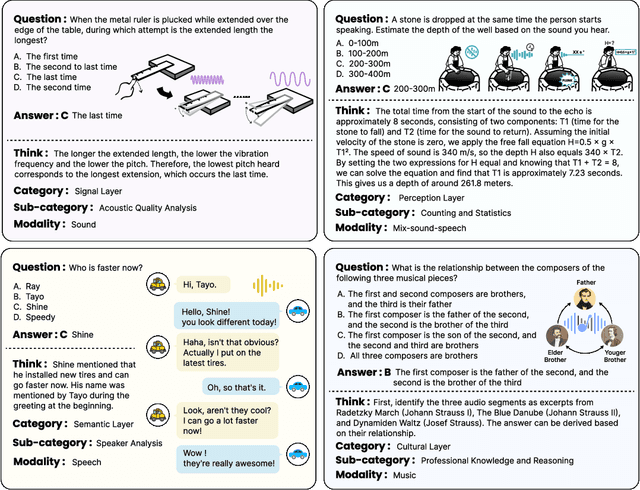
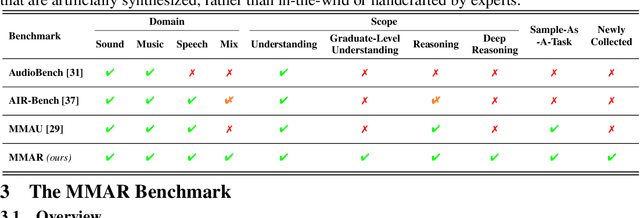
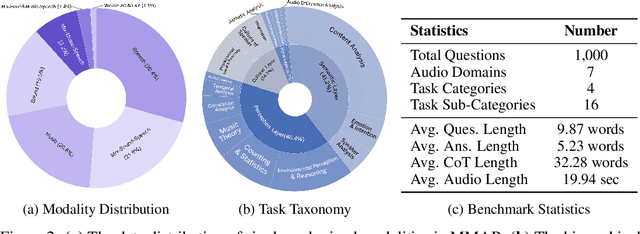
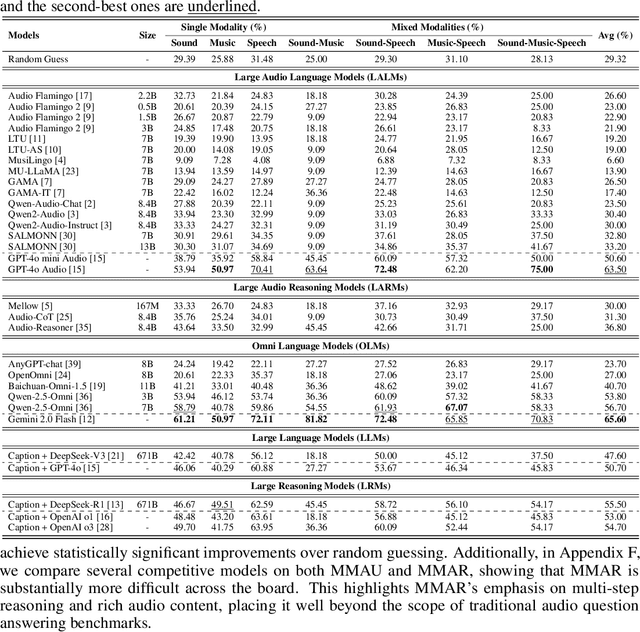
Abstract:We introduce MMAR, a new benchmark designed to evaluate the deep reasoning capabilities of Audio-Language Models (ALMs) across massive multi-disciplinary tasks. MMAR comprises 1,000 meticulously curated audio-question-answer triplets, collected from real-world internet videos and refined through iterative error corrections and quality checks to ensure high quality. Unlike existing benchmarks that are limited to specific domains of sound, music, or speech, MMAR extends them to a broad spectrum of real-world audio scenarios, including mixed-modality combinations of sound, music, and speech. Each question in MMAR is hierarchically categorized across four reasoning layers: Signal, Perception, Semantic, and Cultural, with additional sub-categories within each layer to reflect task diversity and complexity. To further foster research in this area, we annotate every question with a Chain-of-Thought (CoT) rationale to promote future advancements in audio reasoning. Each item in the benchmark demands multi-step deep reasoning beyond surface-level understanding. Moreover, a part of the questions requires graduate-level perceptual and domain-specific knowledge, elevating the benchmark's difficulty and depth. We evaluate MMAR using a broad set of models, including Large Audio-Language Models (LALMs), Large Audio Reasoning Models (LARMs), Omni Language Models (OLMs), Large Language Models (LLMs), and Large Reasoning Models (LRMs), with audio caption inputs. The performance of these models on MMAR highlights the benchmark's challenging nature, and our analysis further reveals critical limitations of understanding and reasoning capabilities among current models. We hope MMAR will serve as a catalyst for future advances in this important but little-explored area.
Towards Flow-Matching-based TTS without Classifier-Free Guidance
Apr 29, 2025Abstract:Flow matching has demonstrated strong generative capabilities and has become a core component in modern Text-to-Speech (TTS) systems. To ensure high-quality speech synthesis, Classifier-Free Guidance (CFG) is widely used during the inference of flow-matching-based TTS models. However, CFG incurs substantial computational cost as it requires two forward passes, which hinders its applicability in real-time scenarios. In this paper, we explore removing CFG from flow-matching-based TTS models to improve inference efficiency, while maintaining performance. Specifically, we reformulated the flow matching training target to directly approximate the CFG optimization trajectory. This training method eliminates the need for unconditional model evaluation and guided tuning during inference, effectively cutting the computational overhead in half. Furthermore, It can be seamlessly integrated with existing optimized sampling strategies. We validate our approach using the F5-TTS model on the LibriTTS dataset. Experimental results show that our method achieves a 9$\times$ inference speed-up compared to the baseline F5-TTS, while preserving comparable speech quality. We will release the code and models to support reproducibility and foster further research in this area.
Interleaved Speech-Text Language Models are Simple Streaming Text to Speech Synthesizers
Dec 23, 2024Abstract:This paper introduces Interleaved Speech-Text Language Model (IST-LM) for streaming zero-shot Text-to-Speech (TTS). Unlike many previous approaches, IST-LM is directly trained on interleaved sequences of text and speech tokens with a fixed ratio, eliminating the need for additional efforts in duration prediction and grapheme-to-phoneme alignment. The ratio of text chunk size to speech chunk size is crucial for the performance of IST-LM. To explore this, we conducted a comprehensive series of statistical analyses on the training data and performed correlation analysis with the final performance, uncovering several key factors: 1) the distance between speech tokens and their corresponding text tokens, 2) the number of future text tokens accessible to each speech token, and 3) the frequency of speech tokens precedes their corresponding text tokens. Experimental results demonstrate how to achieve an optimal streaming TTS system without complicated engineering optimization, which has a limited gap with the non-streaming system. IST-LM is conceptually simple and empirically powerful, paving the way for streaming TTS with minimal overhead while largely maintaining performance, showcasing broad prospects coupled with real-time text stream from LLMs.
SLAM-Omni: Timbre-Controllable Voice Interaction System with Single-Stage Training
Dec 20, 2024


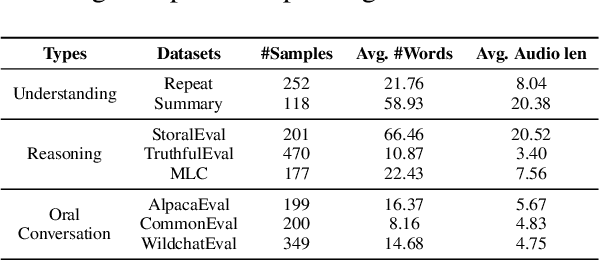
Abstract:Recent advancements highlight the potential of end-to-end real-time spoken dialogue systems, showcasing their low latency and high quality. In this paper, we introduce SLAM-Omni, a timbre-controllable, end-to-end voice interaction system with single-stage training. SLAM-Omni achieves zero-shot timbre control by modeling spoken language with semantic tokens and decoupling speaker information to a vocoder. By predicting grouped speech semantic tokens at each step, our method significantly reduces the sequence length of audio tokens, accelerating both training and inference. Additionally, we propose historical text prompting to compress dialogue history, facilitating efficient multi-round interactions. Comprehensive evaluations reveal that SLAM-Omni outperforms prior models of similar scale, requiring only 15 hours of training on 4 GPUs with limited data. Notably, it is the first spoken dialogue system to achieve competitive performance with a single-stage training approach, eliminating the need for pre-training on TTS or ASR tasks. Further experiments validate its multilingual and multi-turn dialogue capabilities on larger datasets.
SLAM-AAC: Enhancing Audio Captioning with Paraphrasing Augmentation and CLAP-Refine through LLMs
Oct 12, 2024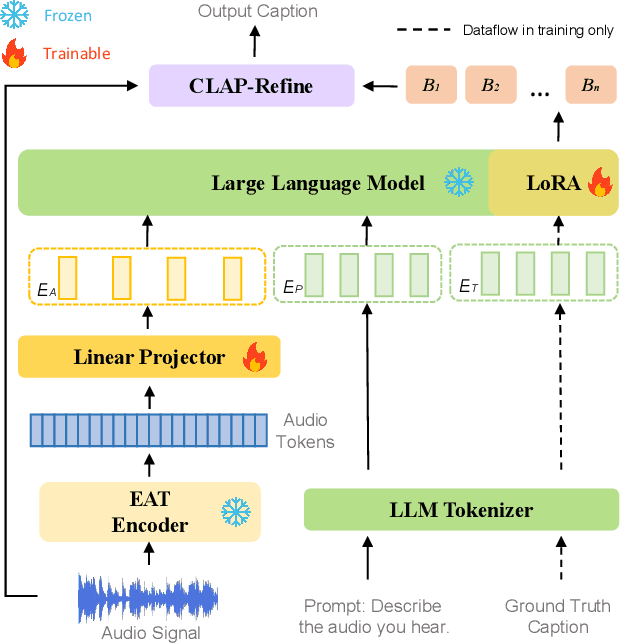



Abstract:Automated Audio Captioning (AAC) aims to generate natural textual descriptions for input audio signals. Recent progress in audio pre-trained models and large language models (LLMs) has significantly enhanced audio understanding and textual reasoning capabilities, making improvements in AAC possible. In this paper, we propose SLAM-AAC to further enhance AAC with paraphrasing augmentation and CLAP-Refine through LLMs. Our approach uses the self-supervised EAT model to extract fine-grained audio representations, which are then aligned with textual embeddings via lightweight linear layers. The caption generation LLM is efficiently fine-tuned using the LoRA adapter. Drawing inspiration from the back-translation method in machine translation, we implement paraphrasing augmentation to expand the Clotho dataset during pre-training. This strategy helps alleviate the limitation of scarce audio-text pairs and generates more diverse captions from a small set of audio clips. During inference, we introduce the plug-and-play CLAP-Refine strategy to fully exploit multiple decoding outputs, akin to the n-best rescoring strategy in speech recognition. Using the CLAP model for audio-text similarity calculation, we could select the textual descriptions generated by multiple searching beams that best match the input audio. Experimental results show that SLAM-AAC achieves state-of-the-art performance on Clotho V2 and AudioCaps, surpassing previous mainstream models.
DRCap: Decoding CLAP Latents with Retrieval-augmented Generation for Zero-shot Audio Captioning
Oct 12, 2024



Abstract:While automated audio captioning (AAC) has made notable progress, traditional fully supervised AAC models still face two critical challenges: the need for expensive audio-text pair data for training and performance degradation when transferring across domains. To overcome these limitations, we present DRCap, a data-efficient and flexible zero-shot audio captioning system that requires text-only data for training and can quickly adapt to new domains without additional fine-tuning. DRCap integrates a contrastive language-audio pre-training (CLAP) model and a large-language model (LLM) as its backbone. During training, the model predicts the ground-truth caption with a fixed text encoder from CLAP, whereas, during inference, the text encoder is replaced with the audio encoder to generate captions for audio clips in a zero-shot manner. To mitigate the modality gap of the CLAP model, we use both the projection strategy from the encoder side and the retrieval-augmented generation strategy from the decoder side. Specifically, audio embeddings are first projected onto a text embedding support to absorb extensive semantic information within the joint multi-modal space of CLAP. At the same time, similar captions retrieved from a datastore are fed as prompts to instruct the LLM, incorporating external knowledge to take full advantage of its strong generative capability. Conditioned on both the projected CLAP embedding and the retrieved similar captions, the model is able to produce a more accurate and semantically rich textual description. By tailoring the text embedding support and the caption datastore to the target domain, DRCap acquires a robust ability to adapt to new domains in a training-free manner. Experimental results demonstrate that DRCap outperforms all other zero-shot models in in-domain scenarios and achieves state-of-the-art performance in cross-domain scenarios.
EAT: Self-Supervised Pre-Training with Efficient Audio Transformer
Jan 07, 2024



Abstract:Audio self-supervised learning (SSL) pre-training, which aims to learn good representations from unlabeled audio, has made remarkable progress. However, the extensive computational demands during pre-training pose a significant barrier to the potential application and optimization of audio SSL models. In this paper, inspired by the success of data2vec 2.0 in image modality and Audio-MAE in audio modality, we introduce Efficient Audio Transformer (EAT) to further improve the effectiveness and efficiency in audio SSL. The proposed EAT adopts the bootstrap self-supervised training paradigm to the audio domain. A novel Utterance-Frame Objective (UFO) is designed to enhance the modeling capability of acoustic events. Furthermore, we reveal that the masking strategy is critical in audio SSL pre-training, and superior audio representations can be obtained with large inverse block masks. Experiment results demonstrate that EAT achieves state-of-the-art (SOTA) performance on a range of audio-related tasks, including AudioSet (AS-2M, AS-20K), ESC-50, and SPC-2, along with a significant pre-training speedup up to ~15x compared to existing audio SSL models.
 Add to Chrome
Add to Chrome Add to Firefox
Add to Firefox Add to Edge
Add to Edge